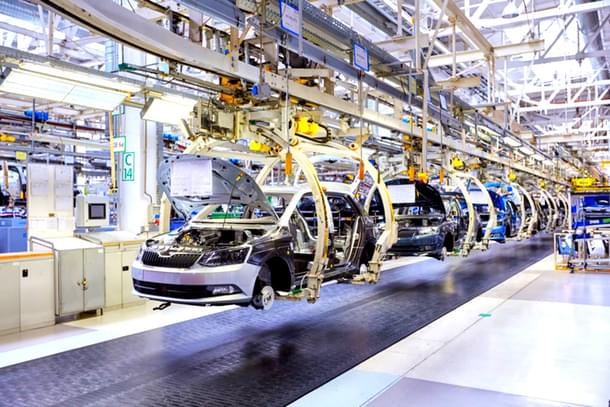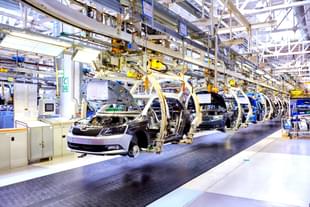Economy
Manufacturing Or Services — What Will Drive The India Growth Story Ahead? A Look At The Evolving Debate
Krishna Dange
Jun 20, 2024, 01:37 PM | Updated Aug 05, 2024, 03:52 PM IST
Save & read from anywhere!
Bookmark stories for easy access on any device or the Swarajya app.


Policymakers in the developing countries often face a predicament — which sector can guarantee a sustained growth momentum in terms of the total economic output vis a vis more jobs and improved incomes: manufacturing or services?
The question elicits responses that vary sharply, provoking a debate in the policy and academic circuits every once in a while.
In the present, the ‘manufacturing versus services’ dichotomy is in focus again due to the recent publications of the economist duo Dr Raghuram Rajan and Dr Rohit Lamba, a commentary by senior economist Dr Bishwanath Goldar and an opinion piece written by wealth management consultant Somnath Mukherjee.
Since the potential of the ‘manufacturing sector’ is at the heart of the debate, a comparative historical overview of India and China is essential here before understanding thoughts expounded on the same by Rajan, Lamba, Goldar and Mukherjee.
While almost all major economies across the world have transitioned from being an ‘agrarian economy’ to building their ‘manufacturing’ prowess for more than a century and then gradually focusing more on the ‘services sector', the Indian experience has been a mixed one.
After gaining independence from the colonial British rule in 1947 which presided over the demise of India’s traditional manufacturing economy, the Jawaharlal Nehru-led administration and subsequent Congress-led governments until the 1990s tried their hands in various ways to boost industrialisation and alternately improve the lives of the country’s citizens.
Combinations applied to bring about the same ranged from socialist state-led industrialisation which gave monopoly in key product categories to state-run companies to state guided capitalism that favoured only a few entrepreneurs close to the ruling government.
Despite all such efforts, India missed the manufacturing bus much needed to enhance employment and kick the macro-economic indicators like that of the gross domestic product (GDP) higher. In the same period, while India remained a closed economy, China gradually opened up to investors across the globe in the late 1970s and 1980s, ironically despite being led by a Communist regime, to became a manufacturing powerhouse by the end of the millennia.
Post liberalisation in 1991, India too has improved its position by leaps and bounds. The country became the fifth largest economy in FY23 and achieved a GDP growth rate of 8.2 per cent in FY24, higher than that of China.
However, the latter continues to outpace India in terms of absolute GDP as well as GDP per capita till date. Notwithstanding this difference, there is one commonality between India and China — it is the ‘services sector’ and not the ‘manufacturing sector’ which occupies a larger share in the GDPs of both economies.
While in the case of China it is the export oriented manufacturing sector (comprising nearly 40 per cent of the GDP) which propels the ‘GDP growth rate’ and not the services sector occupying the larger share, in case of India it was assumed that the ‘services sector’ (at nearly 50 per cent of the GDP) was the growth driver.
This view has now been challenged by Dr Bishwanath Goldar, a senior fellow at the Institute of Economic Growth (IEG) in New Delhi.
'Manufacturing Has Been India’s Growth Driver In Last Two Decades, Not Services' — Dr Bishwanath Goldar
The sector-wise distribution of a country’s GDP has broadly three components — agriculture or the primary sector, industries or the manufacturing sector and services or the tertiary sector. The aggregate real GDP for all such sectors can be calculated through three approaches, namely — production, expenditure and income.
In India, the Central Statistics Office (CSO) under the Ministry of Statistics and Programme Implementation (MoSPI) is tasked with processing and calculating the country’s GDP. The CSO calculates the GDP by using the ‘production approach’ which basically involves addition of market value of all economic activities generated within the country’s territory known as ‘output’ plus ‘indirect taxes’ followed by subtraction of the input cost and subsidies from the figure obtained.
However, to comparatively analyse as to which sector has witnessed more growth or de-growth, economists consider the aggregate gross value added (GVA) by each sector. The GVA is calculated by subtracting the ‘input’ from the 'output.' Finally, an aggregate GVA is obtained by adding GVAs of all sectors.
In a commentary recently published in the Economic and Political Weekly, Dr Goldar of IEG has argued that if one considers the time period of 2003 to 2018, the manufacturing sector’s share in aggregate GVA has doubled from 16 per cent in 2003 to 32 per cent in 2018. In the same period, in the case of the services sector, the GVA has almost remained stagnant.
According to Dr Goldar, the role of manufacturing in driving the growth wasn’t recognised until now since CSO uses the single deflation method to adjust the impact of inflation on the cost of the finished goods while calculating the aggregate GVA. In this, inflation-led rise in the cost of only the input goods is considered.
As pointed out by the senior economist, this is contrary to the universally practised norm of applying double deflation, involving adjustment of input as well as output costs against inflation separately, while calculating the GVA.
Further, relying on the data from 1980-81 to 2021-22 taken from the Reserve Bank of India’s KLEMS database, Dr Goldar identified a trend which shows that the manufacturing sector’s growth had a significant impact on the services sector’s growth, while changes in the services sector did not impact the manufacturing sector as such.
In terms of which of the two sectors can help India sustain a high growth rate and become a developed country by 2047, Dr Goldar suggests that a ‘manufacturing-led’ growth strategy is likely to be more beneficial.
"The beneficial effects on India’s economic growth will probably be much greater from increases in manufactured product exports than increases in services exports and, therefore, appropriate industrial and trade policies are needed to facilitate growth in manufactured product exports," the senior economist said.
'Service Sector Is India's Strength, Policy-Makers Must Give Up Manufacturing Fetish' — Dr Raghuram Rajan And Dr Rohit Lamba
While Dr Goldar's commentary is a recent one, the opening salvo on the 'manufacturing versus services' debate in the recent context was fired by the former Reserve Bank of India governor Dr Raghuram Rajan.
In his collection of essays titled Breaking The Mould: Re-Imagining India's Economic Future (December, 2023), Dr Rajan, presently a Professor of Finance at the University of Chicago along with another US-based economist Dr Rohit Lamba has criticised the Prime Minister Narendra Modi-led National Democratic Alliance (NDA) government's strategy to boost manufacturing in India through a combination of subsidies and tariffs.
“Reimagining India, requires a departure from the manufacturing fetishism that currently dominates government thinking,” Rajan and Lamba said in an follow-up article based on their observations from the recently published book.
According to the authors, while the Union government’s policy of giving subsidies for electronic manufacturing firms has generated jobs to some extent, India’s market share in 'labour intensive sectors' such as textiles and leather manufacturing has gone down.
To substantiate their claim further, Rajan and Lamba point out that despite the Union government devolving huge subsidies to manufacturers under the production linked incentive (PLI) scheme, 11 of the 23 categories of products that make up India’s Index of Industrial Production (IIP) had lower output in June 2023 than in June 2015.
In case of the PLI in particular, Rajan and Lamba observe that the scheme has largely benefitted the large companies with adequate market capital as compared to the medium and small scale enterprises which are yet to recover from the triple shock of demonetisation, implementation of the goods and services tax (GST) and the Covid-19 pandemic.
Further, the economist duo opine that the global markets will not be able to absorb manufactured goods produced by a country like India if its manufacturing capacity grows to that of China.
"China since the start invested heavily in educating its masses compared to India. As a result when China liberalised in the 1980s, they had a large number of people who had honed specific skill sets and knew basics of accounting — both necessary for running a successful business. India on the other hand fared very poorly on this front and thus the problem of low productivity," the senior economist duo note in their book.
In order to sustain high growth rate for the economy, Rajan and Lamba opine that in stead of encouraging setting up of more manufacturing units in terms of number, focus should be on devolving more funds towards education and upskilling of the labour to improve output in the existing industries. Further, they suggest encouraging surplus agricultural labour to move to low-skilled service sector jobs such as plumbing, sweeping, gardening or driving mobile application hailed cabs.
The economist duo posit that since service sector is the driving force behind the Indian economy, the policy makers must focus on higher-skilled ‘manufacturing-related service exports’ such as chip design in stead of venturing into chip making.
However, experts have found Rajan and Lamba's solutions to be problematic.
For instance, when the economist duo suggest surplus agricultural labour to move into other jobs, it is far from the ground reality especially in the states south of the Vindhyas where farmers have been actually complaining about decline in labour availability.
Secondly, the capacity to absorb a large workforce into professions such as gardening or even mobile app-based cabs is lesser than the scope of employment in manufacturing units — whether large, medium or small. Further, the scope of creation of allied businesses catering to the large production units, and thus generating more jobs, is more in the manufacturing sector than services.
'Not Just For Jobs, Manufacturing Push Needed For Balancing Trade Deficits, Secure Geo-Political Interests' — Somnath Mukherjee
Senior wealth management consultant Somnath Mukherjee in a recent column pointed out that since the debate around 'whither manufacturing or services' has largely revolved around whether a focus on the former will create more jobs and drive the GDP growth, the other crucial benefits of an emphasis on manufacturing have been missed out.
"An economy high on services and limited manufacturing runs into an issue with trade deficits. While some services can be traded, like IT, there are limits to their scalability," Mukherjee, presently the chief investment officer at ASK Wealth Advisors, said in an article published in the The Economic Times.
Pointing out at the instances from the recent past when medicine and vaccine production in pharma companies was delayed during the Covid-19 since such companies largely rely on ingredients sourced from China, not focusing enough on manufacturing input goods as well makes India and others over-dependent on China.
"India cannot afford to leave itself politically vulnerable due to a weak manufacturing. Even as India's economy tops global charts on growth, imports from China topped USD 100 billion in FY24. Recent news about factories running idle and waiting for Chinese technicians to operate them vividly drives home the story of dependence.
"India needs a larger manufacturing capacity, and debate around the number of jobs manufacturing can generate is nothing but a waste of time," Mukherjee added.
Staff Writer at Swarajya




